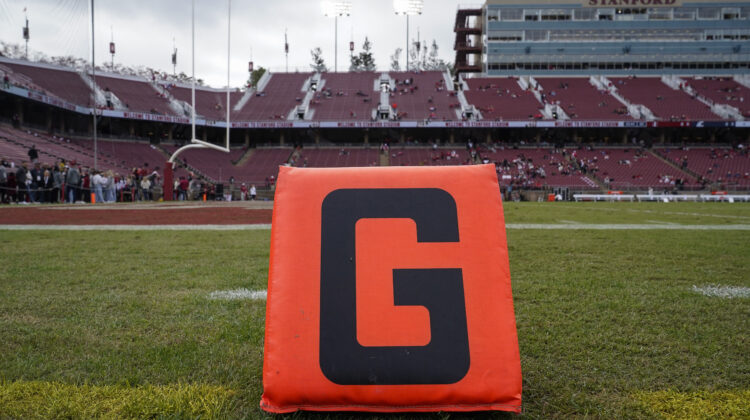Cal’s new chancellor, Richard Lyons, begins his term on July 1. Stanford’s incoming president, Jonathan Levin, takes over one month later.
Lyons and Levin: New leaders for the ancient rivals as unprecedented challenges loom on and off the fields of play.
The football programs have reached a tipping point, pushed to the brink by a seemingly surreal convergence of events:
— Their move into the ACC this summer comes amid an internecine legal fight with the top football brands, Clemson and Florida State, attempting to void the grant-of-rights contract that holds the schools together.
— Mounting financial pressures and heavy reliance on campus subsidies to balance their budgets.
— The existential legal threats facing the NCAA that have spurred the SEC and Big Ten to fill the leadership void and map a future for the industry that looks nothing like the past.
Daunting as they are, the logistics of competing in the ACC are amateur hour for the Cardinal and Bears compared to navigating the roiling landscape.
Are they prepared to break with their longstanding view of college athletics and join the heavyweight football schools in a revenue-sharing arrangement with the players?
Will they make the adjustments necessary for recruiting efforts to thrive in a world of unlimited transfers and uncapped NIL (name, image and likeness) payments?
Will they devote the resources necessary to position their football teams for inclusion in a college football super league that could arise in the next decade?
Nobody knows, because Lyons and Levin haven’t taken charge of their universities, much less laid out a master plan for athletics.
Football success isn’t impossible on either campus. In the 2000s, Cal was one of the best teams in the country. In the 2010s, Stanford was winning Rose Bowls.
But both programs have steadily lost games and relevance within a ruthless sport, where winning increasingly demands an institutional commitment that conflicts with the academic missions and faculty preferences on each side of the Bay.
A few wrong moves over the critical next 12-18 months could doom the Bears and Cardinal to a third-class existence as college football enters its next phase.
So allow us to offer a few suggestions. The list below isn’t long, but it’s wide. Each layer carries complexities, both on campus and across the terrain.
Seize the moment
The move into the ACC, which becomes official on Aug. 2, constitutes a fresh start for both football programs — and the opportunity to remake their images locally.
Marketing efforts have been sorely lacking for years. Stanford has no presence outside a parcel of land on the Peninsula. Cal’s game-day experience needs an upgrade.
The athletic departments serve as the front lines for improvement, but campus support is essential to any material change. Bold thinking is needed.
Of course, that strategy requires campus leaders to confront their deepest fears: That plowing resources into football will turn the universities into jock schools; that embracing football will damage their academic reputations, anger their Olympic sports teams and send the faculty into revolt.
But the current approach, with football kept at a distance and viewed as a necessary evil, will guarantee continued mediocrity, ongoing irrelevance and ultimately, a one-way ticket into the competitive abyss.
The best way to ensure success for tennis and swimming, golf and softball in the next era of college sports? Win on Saturday.
Win on Saturday, and the money flows — not only from ticket and concession sales but also from philanthropy and brand expansion.
The most successful alumni events in Stanford history didn’t take place in the engineering building. They weren’t reunions on campus. They were Rose Bowl tailgate parties.
You know what else flows from winning? Applications for admission, which subsequently allows acceptances rate to drop and selectivity to rise.
Stanford saw that first-hand during its run on the national stage from 2009-2012. Campus officials termed the “Andrew Luck effect.”
Lyons and Levin shouldn’t apologize for football. They should embrace it.
Make tough decisions
The Hotline never shies from uncomfortable topics, and eliminating sports is the most uncomfortable topic in college athletics. But Lyons must seriously consider downsizing the scope of Cal’s department.
Only football and men’s basketball are profitable. In that regard, the Bears are no different than dozens of power conference schools across the country. But Cal sponsors far more sports — 30 — than most of its peers.
Meanwhile, the Bears needed $34 million in university support last year just to turn a slight surplus, according to the financial report submitted to the NCAA.
And now comes a next-level challenge: Competing in the ACC while receiving less than a full share of the conference’s media rights revenue for most of the 12-year arrangement.
Cutting sports would reduce expenses, bring the budget in line and free up cash for football operations.
Stanford also relies on campus support and reported a $21 million operating deficit in the 2023 fiscal year. The school has all the money needed to deal with partial revenue shares in the ACC, as long as Levin is committed to a sufficient allocation of campus dollars for athletics.
Additionally, Lyons and Levin should embrace NIL, the NCAA-sanctioned process by which athletes can receive compensation for endorsements and promotional work.
But tacit approval isn’t enough. Campus leadership must make clear to every constituent and stakeholder — board members and tenured professors alike — that NIL opportunities are not only acceptable but encouraged and beneficial for athletes in every sport.
Start the lobbying
We saved the most pressing task for last.
The Bay Area schools were caught by surprise when the Pac-12 imploded last summer, according to multiple conference sources. They cannot make the same mistake again.
Lyons and Levin must be cognizant of the potential for the ACC to implode. After all, Clemson and Florida State have filed lawsuits seeking to void the grant-of-rights agreement that binds them to the ACC until 2036.
If one school bolts, the other will follow — and so will North Carolina, the institution most coveted by the Big Ten and SEC.
At that point, the conference would become a shell of itself … or fracture completely.
What then for the Bears and Cardinal?
They would have the option to join Washington State and Oregon State in rebuilding the Pac-12. Or they could attempt to secure membership in the Big Ten alongside USC, UCLA, Oregon and Washington, which are entering the conference this summer.
A six-school western wing would work on numerous levels, reducing travel demands on athletes at both the West Coast and Midwest schools. But additional westward expansion must make sense for Fox.
Fox controls the Big Ten’s media rights through its majority stake in the Big Ten Network and thus is responsible for funding any realignment efforts.
Oregon and Washington gained admittance last summer because Fox came up with the money to compensate the newcomers without dipping into the pot reserved for the other 16 members.
Had Fox believed Cal and Stanford were worthwhile, they would be headed into the Big Ten, not the ACC.
Would anything change in a post-ACC world? Maybe not. But the Bears and Cardinal cannot assume a second rejection.
Make the case to network executives that Fox and the Big Ten would benefit from the presence of two world-class schools in the Bay Area, with all its high-tech money and thousands of Big Ten alums.
Make it clear that full revenue shares aren’t necessary. Oregon and Washington are entering the Big Ten as half-share members. The Bay Area schools should be willing to join at 25 percent.
The Big Ten presidents aren’t the hurdle. Given the option, they would love to align with the Nobel Prize heavyweights.
But they won’t admit Cal and Stanford if the move leads to a reduction in the media revenue that flows to each school. Fox would have to cover the expense, as it did with Oregon and Washington.
It won’t be an easy sell. Lyons and Levin are businessmen. But starting this summer, if not today, they need to become lobbyists.
They are taking charge with the future at stake for both athletic departments. Whether they like it or not, the path to prosperity is 100 yard long.
*** Send suggestions, comments and tips (confidentiality guaranteed) to pac12hotline@bayareanewsgroup.
*** Follow me on Twitter/X: @WilnerHotline
*** Pac-12 Hotline is not endorsed or sponsored by the Pac-12 Conference, and the views expressed herein do not necessarily reflect the views of the Conference.
Related posts:
 Wilner Hotline: Utah Smokes Stanford Friday Night, Controls Pac-12 South
Wilner Hotline: Utah Smokes Stanford Friday Night, Controls Pac-12 South
 Wilner Hotline – Pac-12 football 2022 win totals: Our breakdown of the schedules
Wilner Hotline – Pac-12 football 2022 win totals: Our breakdown of the schedules
 Wilner Hotline – Pac-12 Networks analysis and media strategy
Wilner Hotline – Pac-12 Networks analysis and media strategy

Washington quarterback Michael Penix Jr. celebrates after the Sugar Bowl (AP Photo/Butch Dill)
Pac-12 bowl review: Breaking down the highs (UW, Arizona) and lows (Cal, OSU) and everything in between

